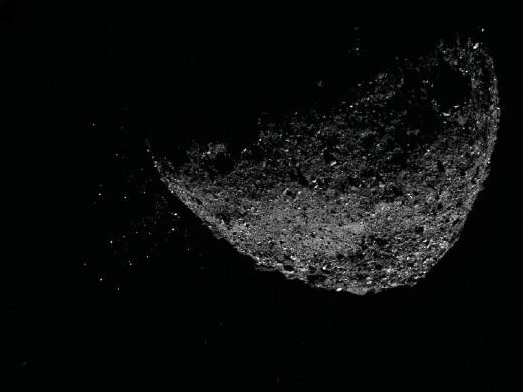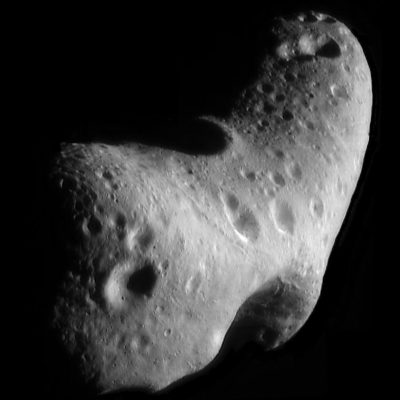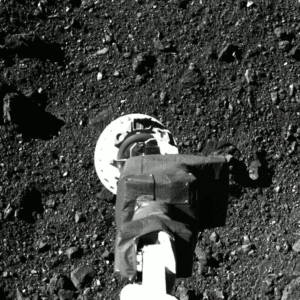
Asteroid missions probe diverse questions, from planetary defense to the origin of life
Asteroid dirt, or regolith, flying off the surface of the asteroid Bennu—captured in a still image on Jan. 6, 2019 by the OSIRIS-REx spacecraft’s NavCam 1—was the payload as the spacecraft returned home to Earth. (Credit: NASA/JPL/Goddard/University of Arizona/Lockheed Martin)
Asteroid science, says Dan Scheeres, is about the past and the future.
Asteroids—and how to get to them—have been the major focus of Dan Scheeres’s three-decade–long career. The aerospace engineer spoke Oct. 5 about the current state of asteroid science during the Council for the Advancement of Science Writing’s New Horizons in Science briefings at the virtual ScienceWriters2021 conference.
Fresh out of his celestial mechanics graduate degree program, Scheeres found himself at NASA’s Jet Propulsion Laboratory in time to join the navigation team for the Near Earth Asteroid Rendezvous, or NEAR, mission to the asteroid Eros.

“They had just had this mission that they were going to work on come in, which was the NEAR mission … and so it was sort of just luck of the draw. ‘[A supervisor] said, well, let’s put you on this mission over here.’” Scheeres said in an interview. “And what I discovered is, once you get to an asteroid there were a lot of open questions about, what even would happen with the spacecraft? How do you orbit? What sort of things do you need to do? And what I found is, all my theoretical expertise from celestial mechanics was really a great fit with understanding what goes on in asteroids.”
NEAR entered orbit around the asteroid named for the Greek god of love on Valentine’s Day, 2000—a coincidence, Scheeres said by email, even though the mission manager at the time particularly liked the idea of having orbit entry happen on days that have some significance. After landing on the surface one year later and quickly losing signal, the spacecraft became the first ever to orbit and land on an asteroid.

Today Scheeres is a distinguished professor and holds the Seebass Chair of aerospace engineering at the University of Colorado, Boulder. His early work was just the introduction to a career spent seeking answers to unresolved questions about asteroids. The seven missions to asteroids that would follow—some completed, some in progress, some still in development—grew out of NEAR’s technology and discoveries.
“The heart of scientific exploration of asteroids is ‘let’s go to different categories of asteroids to actually understand what they are really like, what their details are’” he said. Scheeres was in Japan when the Japanese Aerospace Exploration Agency, or JAXA, sample collection mission Hayabusa 1 arrived at the asteroid Itakowa. “You actually saw what one of these tiny little chunks of rock looks like up close,” he said. “As soon as you see that … your vision of what asteroids are undergoes a change.”
Asteroids open a window into the strange ways that matter behaves in space. Scheeres described asteroids as a unique form of matter, with forces such as friction balanced against gravity. “It’s almost like this microgravity aggregate that we can’t make on Earth.”
That is where Scheeres’ research comes in. He’s principal investigator of the Janus fly-by mission, set to launch in 2022. Two spacecraft will travel to different binary asteroid systems—two asteroids orbiting one another—to probe their poorly understood physics. “The whole ‘Star Wars thing’ of asteroids next to each other? That’s not true.” Scheeres said. Only about 15% of asteroids are close enough—within a few kilometers of one another—to become binaries, and, of these, only a small percentage are similar in size. Most comprise a tiny moonlet orbiting a much larger body. So the binary asteroids Janus will study are, as Scheeres describes them, “exceptional.”

All asteroid research balances the understanding of fundamental scientific principles against more immediately practical applications. Human exploration and asteroid mining are still the stuff of science fiction, yet asteroid deflection for planetary defense is an active—and crucial—area of research. Determining the threat from Bennu, the asteroid most likely to crash into Earth, is one purpose of the Origins Spectral Interpretation Resource Identification Security—Regolith Explorer (OSIRIS-REx) spacecraft mission. Bennu has a low 1 in 1,750 chance of hitting Earth through the year 2300.
Another mission, DART, the Double Asteroid Redirection Test, is NASA’s first aimed at testing a planetary defense strategy. It will travel to Didymos, a binary system of one large asteroid and its moonlet, to try shifting the smaller body’s orbit by crashing into it. “That will tell us how efficient such an impact trajectory can be for nudging an asteroid out of the way,” Scheeres, said.
But asteroid science is not just about the future; researchers are also using it to understand the past. Asteroids are remnants of the early solar system, dating back to its formation, and so can reveal key information about the positions of the planets and the origins of life itself.
Through sample collection missions such as NASA’s OSIRIS-REx and JAXA’s Hayabusa 2 to Ryugu, scientists are seeking to learn about the beginnings of molecules found in biological systems. Hayabusa 2 returned its sample in December 2020 and OSIRIS-REx is on its way home from Bennu with a stash of asteroid dirt, called regolith.
Two NASA missions, Lucy and Psyche, are focused on solar system formation. Lucy, a fly-by mission to Jupiter’s trojan asteroids—4.5 billion-year-old time capsules trapped by the gas giant’s gravity that share its orbit around the sun—launched on Oct. 16. Psyche’s eponymous target might be the ancient core of a former Earth-like planet that met an uncertain fate.
Now Scheeres is preparing for Janus, which will hitch a ride with Psyche in 2022. At about 5% of the cost of missions like OSIRIS-REx and Lucy, it still holds the possibility of important new discoveries. “I’m positive that there are going to be things that we just didn’t expect,” Scheeres said. “And that’s the fun part.”